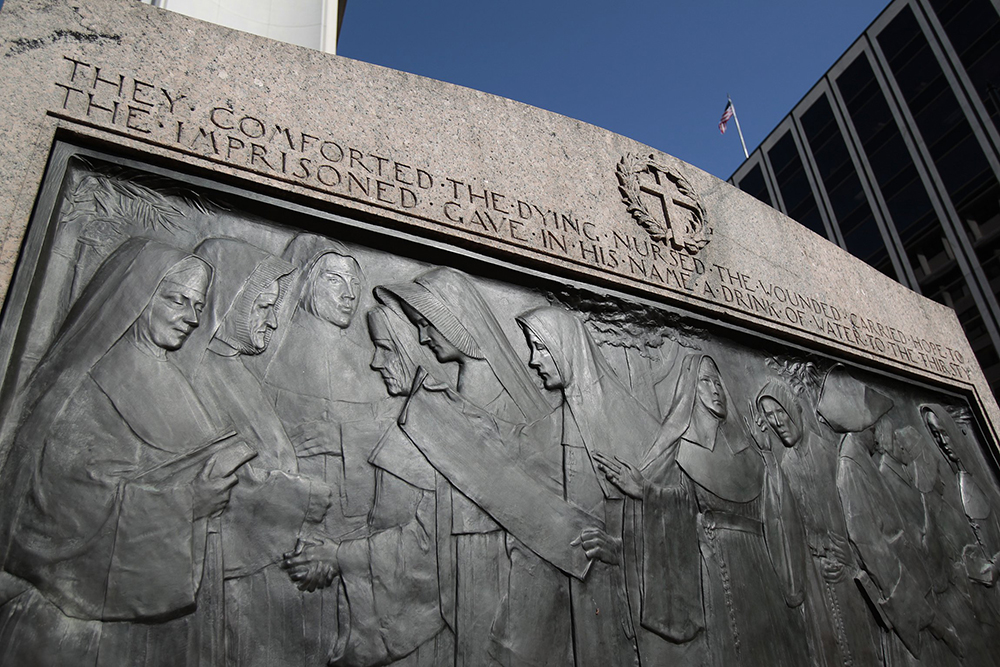
WASHINGTON — When people think about the Civil War, women religious are probably not the first image that comes to mind, but they might think differently after seeing an almost-hidden monument to these sisters in Washington.
On a small triangle of federal park across the street from the Cathedral of St. Matthew the Apostle sits the Nuns of the Battlefield Monument, which honors sisters from 12 religious orders who served as nurses on Civil War battlefields and hospitals caring for the wounded.
The monument, erected in 1924, features a large bronze relief panel with 12 sisters in religious habits representing their different orders. It has two bronze figures at both ends: “The Angel of Peace” and “Patriotism.”
The inscription: “They comforted the dying, nursed the wounded, carried hope to the imprisoned, gave in his name a drink of water to the thirsty” is engraved on the stone. Underneath the image it says: “To the memory and in honor of the various orders of sisters who gave their services as nurses on battlefields and in hospitals during the Civil War.”
More than 600 sisters served as nurses during the Civil War doing everything from bandaging soldiers in the battlefield to coordinating makeshift hospitals. The 12 orders depicted in the statue for their involvement are: Sisters of St. Joseph; Sisters of Our Lady of Mount Carmel; Sisters of St. Dominic; Sisters of St. Ursula; Sisters of the Holy Cross; Sisters of the Poor of St. Francis; Sisters of Mercy; Sisters of Our Lady of Mercy; Sisters of Charity; Sisters of Charity of Emmitsburg, Pennsylvania.; Sisters of Charity of Nazareth, Kentucky; and Sisters of Divine Providence.
These women religious provided food, water, bandages, and basic medical care. They also gave spiritual solace to soldiers who requested it: praying with them, distributing religious medals, baptizing the dying, and writing letters home to soldiers’ families.
At Gettysburg and other Civil War battles, at least 300 Daughters of Charity ministered to soldiers on both sides of the war.
St. Francis Xavier Church in Gettysburg served as one of these improvised hospitals. The church’s vestibule became an operating room, its sanctuary was a recovery room, and the pews functioned as cots for more than 200 wounded soldiers. The church, which is still a parish today, pays tribute to the nuns’ ministry with a stained-glass window depicting the Daughters of Charity caring for wounded soldiers.
Sister Betty Ann McNeil, a Daughter of Charity and former archivist with the order who is currently a Vincentian Scholar-in-Residence at DePaul University in Chicago, has written about what she says is the sisters’ under-told role in the Civil War.
Their stories haven’t been told, she said, because they didn’t take pictures of themselves on the battlefields or promote the work they were doing. But in her role as archivist, she found handwritten accounts from some sisters who helped in the war relief effort which she included in her 2015 book, “Balm of Hope: Charity Afire Impels Daughters of Charity to Civil War Nursing.”
She told DePaul Magazine that she tried to identify every sister mentioned in the book to serve as a resource to those with a genealogical interest, for students studying the humanity and human suffering of the war and to educate people “about the critical role the Catholic sisters played as nurses.”
The monument paying tribute to the work of these sisters was prompted by Ellen Ryan Jolly, national president of the Ladies’ Auxiliary of the Ancient Order of Hibernians, who campaigned for the statue for over a decade.
Accounts of the monument’s history, published by the Mercy Sisters and American Catholic Studies, note that her proposal was finally approved by Congress in 2018. The monument did not get federal funding, so the auxiliary raised $50,000 for it and commissioned Jerome Connor, the Irish American sculptor, to design it.
Nearly 6,000 people attended the statue’s unveiling on a Saturday afternoon in September, including Mercy Sister M. Madeline O’Connor, then 81, one of the three surviving sisters from the Civil War at the time.
The nun was greeted with cheers, applause, and even bows from officials and the audience. An account of that day’s ceremony by the Washington Post picked up on the crowd’s sentiment, saying: “The eyes of Sister Madeline were not the only eyes in that vast throng which glistened with tears.”
